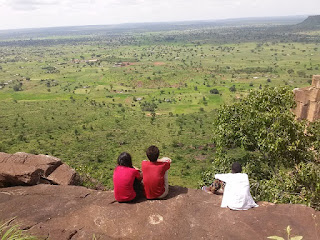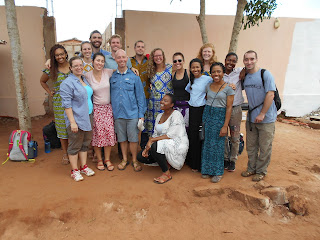I think I often start these posts with disbelieving comments
about how much time has passed, but seriously, wow: last week, I celebrated my
six month anniversary of being in country. Holy Cow!
The first trimester at school wrapped up last week, and the upcoming
week the students have “compositions,” or final exams. I’ve got a little bit of
proctoring to do before my two week Congé du Noel! School has been mostly
uneventful – lesson planning, teaching twelve hours each week, struggling to
keep control of classes overflowing with students, and little moments of
success when kids sensibly string a sentence together. Go, kids!
A few weeks ago, fellow PCV Sarah (who is also a teacher in the
neighboring village of Bombuaka) came and sat in on a few of my classes. She
did me a favor and snapped a few pictures – enjoy!
Reviewing for the Test
Kids Getting Into the Spelling Competition
Now that we’re passed the initial three months at site –
which Peace Corps encourages us to take as time for integration and initial
project planning – it’s also been time to start doing other projects.
Second-year Savanes volunteers Matt and Travis have been
working with the S.O.S. Orphanage in the regional capital of Dapaong, and
invited new volunteers to help with some information session projects they were
doing there. For three weekends in a row, the plan was to hold
“sensibilisations” (a French word for which I do not know the exact English
translation) for women’s and agriculture groups associated with the orphanage.
Each weekend, an army of us – 13 volunteers in total! –
descended on S.O.S. to do these trainings – one on nutrition, one on seed
propagation and compost, and one on double digging (yeah I don’t know what is
either).
Some of us did actual presentations, others distributed pre-
and post- tests for Monitoring and Evaluation purposes (very important), and
the rest were on “keep all these goddamn kids out of the learning area!” duty.
All fun and interesting – I was mostly responsible for the latter two tasks.
Check out some great photos of this work, courtesy of
photographer and beard-grower extrordanaire, Aaron Sepulveda:
Distributing Pre-Tests
Health Volunteer Travis Introducing the Session
Agriculture Volunteer Michael Supervising the Double Digging
I also teamed up with Health sector volunteers Jenny and
Ashiana (and my teacher neighbor, Sarah!) to host an afternoon of sex-ed with
the girls at my school. In the school system, there is a curriculum of sex-ed,
called “ESEPSI,” (Education Sexuelle et la Prevention de SIDA et IST), but it
is taught by my aging male school director (not an ideal role model for young
girls, especially on a sensitive topic riddled with stigma for women). Also,
with the high rates of early pregnancy that cause girls to drop out of school,
we believe that it’s important to address the issues of choice, and sex as a
partnership and conversation, to work towards empowering girls to make healthy
decisions for their futures.
So, armed with these themes, anatomical illustrations, and a
few empowering Beyonce quotes (translated into French, of course), we spent the
afternoon encouraging conversation about gender roles, contraception, and the
nitty-gritty of the vagina.
We also gave them candy, which turned into a terrifying
stampede.
Here’s some photos, courtesy of Jenny, and our official
media volunteers for the event, Morgan and Blair:
Ashiana and I Talking about Gender Roles
Jenny, Sarah, 150 Togolese Teenagers, Me, and Ashiana
Morgan, Sarah, Me, Ashiana, Jenny, and Blair After the Event
(Plus Bonus Nacho the Dog and Student Photobomber)
(Plus Bonus Nacho the Dog and Student Photobomber)












































